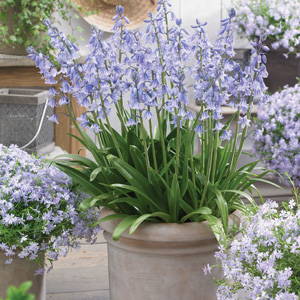Spanish Bells Growing Guide

What is Spanish Bells?
Spanish Bells (Hyacinthoides hispanica) also known as Bluebells or Woodland Bells are bulbous perennials that produce attractive bell shaped flowers. From the family Hyacinthaceae they are native to Portugal and Spain. Spanish bells form a clumping mass of strappy green foliage where their flower stalks rise about them. The foliage appears in Winter, before the flowers appear in late Spring. Spanish bells have either blue, pink or white flowers. They grow well in either a full sun to part shaded position with morning sun. The soil should be free draining. Spanish bells require regular soakings in Spring, but during Summer can be kept dry as they begin to go into dormancy. They are a cold hardy bulb that is ideal for naturalising.
Benefits of Growing Spanish Bells
Spanish bells are an easy to grow and low maintenance bulb that you can forget about after planting. They enjoy being left to thicken into clumps as they slowly multiply. They are often grown en masse under trees or on banks. Spanish bells suit rockery plantings, grassy banks or as boarders.
How to Grow Spanish Bells
Climatic Zones
Cool, temperate, arid.
Plant Size
Height: 20-40m, Width: 10cm
When To Plant Spanish Bells
Plant in Autumn
Soil Preparation
They like well drained, rich in organic matter. Work compost or well broken down manure through the soil before planting.
How To Plant Spanish Bells
Plant in full sun to part shade, 8cm apart with the bulb at a depth of 5cm. Plant with the pointy end facing up
Spanish Bells Plant Care
Water regularly during Spring when its the growing and flower season.
Spanish bells should be left in the ground undisturbed. Clumps may need to be divided every 3 years or so as they get larger. If digging is required do so in January when the bulb is in dormancy.
Remove spent flowers when the flowering season has finished.
Pests and disease are rare. Watch out for snails and slugs.







